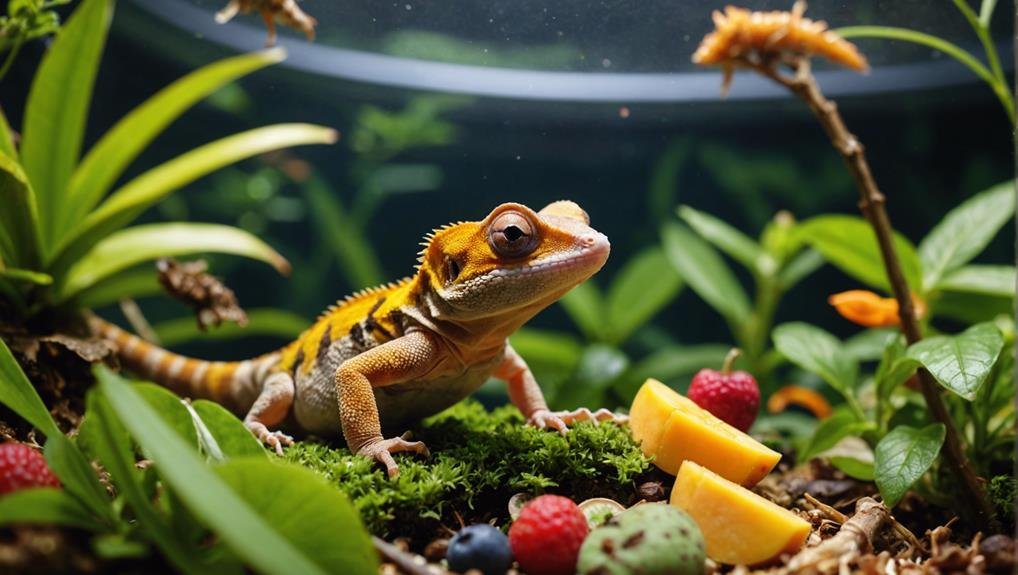When considering what crested geckos eat, you might initially think of insects like crickets and mealworms, which form a significant part of their diet. However, their nutritional needs go beyond live prey. You’ll need to understand the importance of commercial crested gecko food, which provides a balanced nutrition essential for their health. Additionally, incorporating fruits and occasional flower nectar can greatly enhance their diet. But how do you ensure they get everything they need without overcomplicating the process? Let’s explore the specifics of creating a well-rounded diet for your crested gecko.
Key Takeaways
- Crested geckos eat nocturnal insects like crickets, roaches, and moths for essential proteins.
- They enjoy a variety of fruits such as mango, pear, banana, and grapes.
- Commercial foods like Pangea and Repashy provide balanced nutrition.
- Hatchlings and juveniles thrive on tiny insects like fruit flies and pinhead crickets.
- Dust feeder insects with calcium supplements to support bone health.
Wild Diet of Crested Geckos
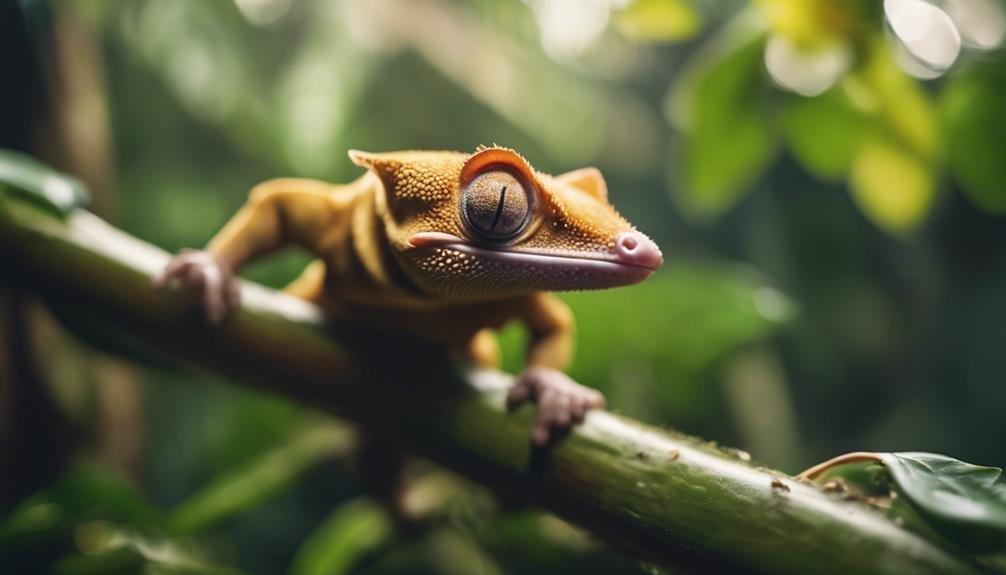

Creamed geckos primarily feast on nocturnal insects like roaches, moths, spiders, and crickets in the wild. These insects form a significant part of their wild diet, providing essential proteins and nutrients. However, their diet isn’t limited to just insects. Crested geckos also consume fruit, which adds nutritional diversity to their meals. They relish flower nectar, though their preferred plant species remains unknown.
You might be surprised to learn that their stomach contents can reveal various food sources. Wild crested geckos ingest pollen and even small vertebrate prey alongside insects and fruit. This varied diet ensures they get a balanced intake of nutrients, which is pivotal for their health and vitality.
Understanding what crested geckos eat in the wild can help you provide proper care for them in captivity. Mimicking their natural diet as closely as possible is key. Including live insects in their captive diet ensures they receive nutritional diversity similar to what they’d find in their natural habitat.
Pet Crested Gecko Diet
Providing a balanced diet for pet crested geckos involves combining live insects with commercial crested gecko food. It would be best to feed them a mix of both to guarantee your gecko thrives. Insects like crickets and roaches are staples, providing essential protein. Supplement these with super, meal, wax, and silkworms to create a diverse diet.
Commercial food is specifically formulated to meet the nutritional needs of crested geckos. Many keepers rely solely on these products to prevent dietary deficiencies. These foods usually contain a balanced mix of fruits, proteins, and essential vitamins and minerals. Feeding your gecko commercial food ensures they receive consistent nutrition.
Young geckos should opt for appropriately sized insects such as fruit flies and pinhead crickets. These smaller insects are easier to handle and digest, supporting their growth and development. Always consider the size and age of your gecko when choosing their diet components.
Offering a diverse diet is essential. Mixing live insects with commercial food provides your pet crested gecko with a balanced diet that supports their health and prevents nutritional deficiencies. This approach ensures they receive all the essential nutrients they need to thrive.
Hatchling and Juvenile Diet
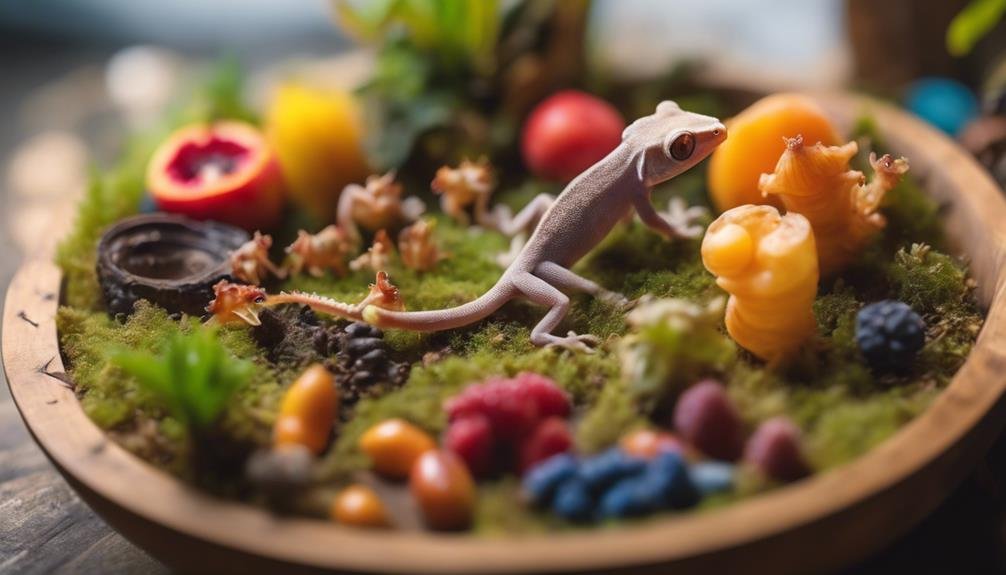

Hatchling and juvenile crested geckos thrive on a diet that includes tiny insects and commercial gecko food, ensuring they receive the nutrients needed for healthy growth. When feeding hatchlings, it’s important to offer appropriately sized small insects like fruit flies or pinhead crickets to prevent choking hazards. Avoid larger insects like mealworms or superworms, as they can be too challenging for young geckos.
A varied diet combining small insects and commercial crested gecko food is vital to support the healthy growth of your hatchling or juvenile. Commercial crested gecko food is specially formulated to provide a balanced diet rich in nutrients, making it a reliable base for their dietary needs. However, some keepers prefer a more insect-based diet for young geckos to ensure adequate protein and other essential nutrients.
It’s common for hatchlings to refuse food initially, but they typically start feeding after a few days once they’ve settled into their new environment. By offering a balanced diet and monitoring their eating habits, you can help guarantee the development and well-being of your young crested gecko, fostering a foundation for a healthy and robust adult life.
Feeding Feeder Insects
Feeding feeder insects like crickets, dubia roaches, and silkworms provides essential nutrients and mental stimulation for your crested gecko. Always make sure these insects are of an appropriate size to prevent choking hazards. Before feeding, dust the feeder insects with calcium supplements, such as Arcadia Earthpro-Ca or Repashy SuperCal, to support your gecko’s bone health.
Gutloading feeder insects for at least 24 hours with nutritious foods like Arcadia Insect Fuel or Repashy Bug Burger enhances their nutritional value. This step is important for your gecko’s overall well-being, providing them with the necessary nutrients.
| Feeder Insect | Gutloading Food | Calcium Supplement |
|---|---|---|
| Crickets | Arcadia Insect Fuel | Arcadia Earth pro-Ca |
| Dubia Roaches | Repashy Bug Burger | Repashy SuperCal |
| Silkworms | Fresh Vegetables | Repashy SuperCal |
Using calcium powder with or without vitamin D depends on whether your gecko is exposed to UVB light. Suppose your gecko receives adequate UVB light exposure. In that case, you can use calcium powder without vitamin D. However, if UVB light exposure is limited, ensure the calcium powder includes vitamin D to maintain your gecko’s overall health. By carefully selecting and preparing these feeder insects, you provide a balanced diet that promotes your crested gecko’s physical and mental health.
Preparing Commercial Diets
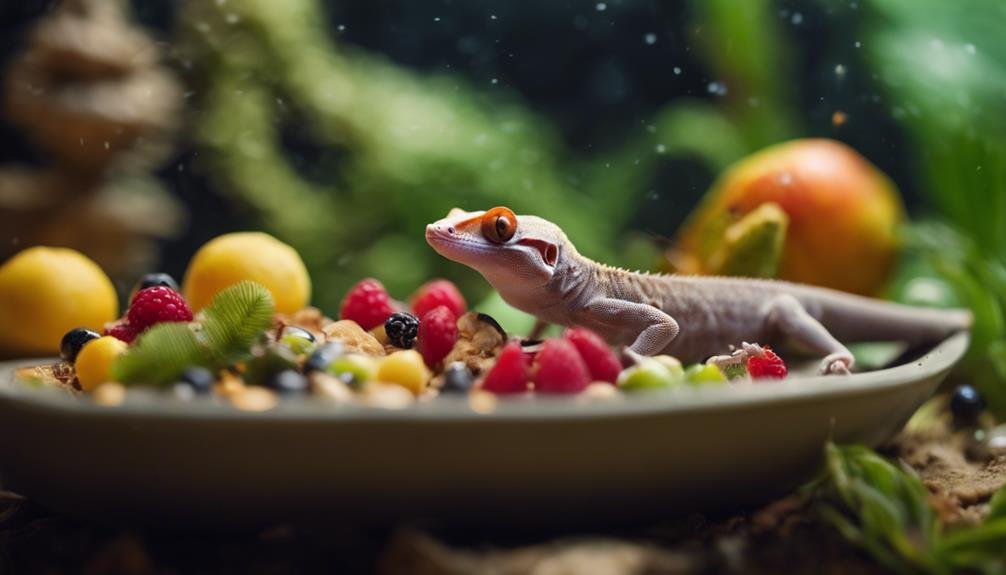

When preparing commercial diets for your crested gecko, you’ll find that products like Pangea and Repashy offer a balanced and convenient solution. These commercial diets come in powdered form and must be mixed with water before feeding. They provide essential nutrients for your gecko’s health and well-being.
To get started, follow the instructions on the package. Typically, you’ll mix one part powder with two parts water, but the ratio can vary depending on the brand and specific product. Once the mixture reaches a smooth consistency, it’s ready to serve.
Feeding frequency should be adjusted based on your gecko’s age and nutritional needs. Younger geckos often require more frequent feedings, while adults can be fed less frequently. It’s important to monitor your gecko to ensure they eat enough without developing any nutrient deficiencies.
Offering a variety of commercial diets, such as alternating between Pangea and Repashy, can help prevent any potential nutrient deficiencies and keep your gecko interested in their food. These prepared diets have been specifically formulated to meet the nutritional needs of crested geckos, making them an excellent choice for any gecko owner.
Feeding Schedule
A well-planned feeding schedule is essential for maintaining the health and well-being of your crested gecko. Feeding your crested gecko every other day or 3-4 times a week would be best. Juveniles and hatchlings might need more frequent meals, while adults can thrive on fewer feedings. Ensuring a varied diet that includes insects, a commercial crested gecko diet, and occasional fruit treats is important for achieving nutritional balance.
Grab Gecko Food for your pet; here’s the link:
https://www.amazon.com/dp/B00061URJC?tag=mus0a-21
Here is a quick reference table for feeding schedules:
| Age Group | Feeding Frequency | Notes |
|---|---|---|
| Hatchlings | Daily | Higher frequency for growth |
| Juveniles | Every other day | Maintain a varied diet for proper development |
| Adults | 3-4 times a week | Monitor weight and behavior for adjustments |
| Senior Geckos | Three times a week | Adjust based on activity and health changes |
Adjust the feeding frequency based on your crested gecko’s age, weight, and activity level to avoid overfeeding or underfeeding. Monitoring your crested gecko’s weight and behavior is important. You may need to adjust the feeding schedule if you notice significant weight changes or unusual behavior. This approach helps maintain ideal health and well-being for your beloved pet.
Fruits for Crested Geckos
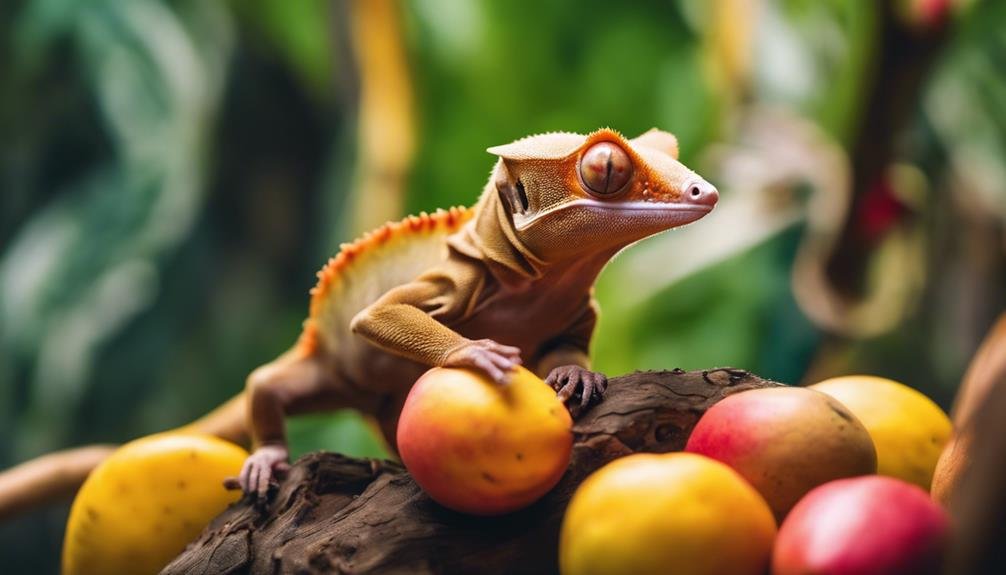

In addition to a structured feeding schedule, offering fruits like mango, pear, and banana can provide your crested gecko with added nutritional variety. These fruits aren’t only delicious but can also benefit their overall diet.
Including fruits like grapes in your crested gecko’s diet can serve as occasional treats, enhancing their eating experience and ensuring they receive a broad spectrum of nutrients.
To incorporate fruits into your crested gecko’s diet, mash them and place them in feeding bowls. This method makes consuming and digesting the fruits easier for your crestie. Remember, fruits should be in moderation and not replace their primary diet of commercial crested gecko food and live insects. Overfeeding fruits can lead to nutritional imbalances, so it’s essential to maintain a balanced diet.
Understanding the natural diet of crested geckos will help you select suitable fruits and offer them appropriately. Providing mango, pear, banana, and grapes as part of their diet ensures that your crested gecko enjoys a varied and nutritious diet.
These occasional treats can contribute to their overall health and happiness.
Water Requirements
Ensuring your crested gecko stays hydrated is essential for its health and well-being. Crested geckos primarily hydrate by licking water off the walls of their enclosure or from plants. As a result, regularly misting the enclosure is important to create a humid environment that supports their hydration needs. Misting should be done at least once or twice a day to provide ample water droplets for them to lick.
Always ensure fresh water is available in a shallow water dish within the enclosure. This offers an additional source of hydration and gives your gecko the option to soak if it feels the need. However, it’s critical to ensure the water dish is shallow to prevent any risk of drowning.
Dehydration can be a serious issue for crested geckos, leading to health complications. To avoid this, maintain the humidity levels within the enclosure between 60-80%. Be cautious not to let the substrate become excessively wet, which can promote bacterial growth and cause health problems.
Conclusion
To maintain your crested gecko healthy and happy, provide a balanced diet of live insects, commercial crested gecko food, and occasional fruits like mango and banana.
Don’t forget to mist their enclosure and offer a shallow water dish for hydration.
Monitoring their diet and offering various food options guarantees they receive all the essential nutrients they need.
Remember, a well-fed gecko is a thriving gecko!

